This post may contain affiliate links. Please read our disclosures for more information.
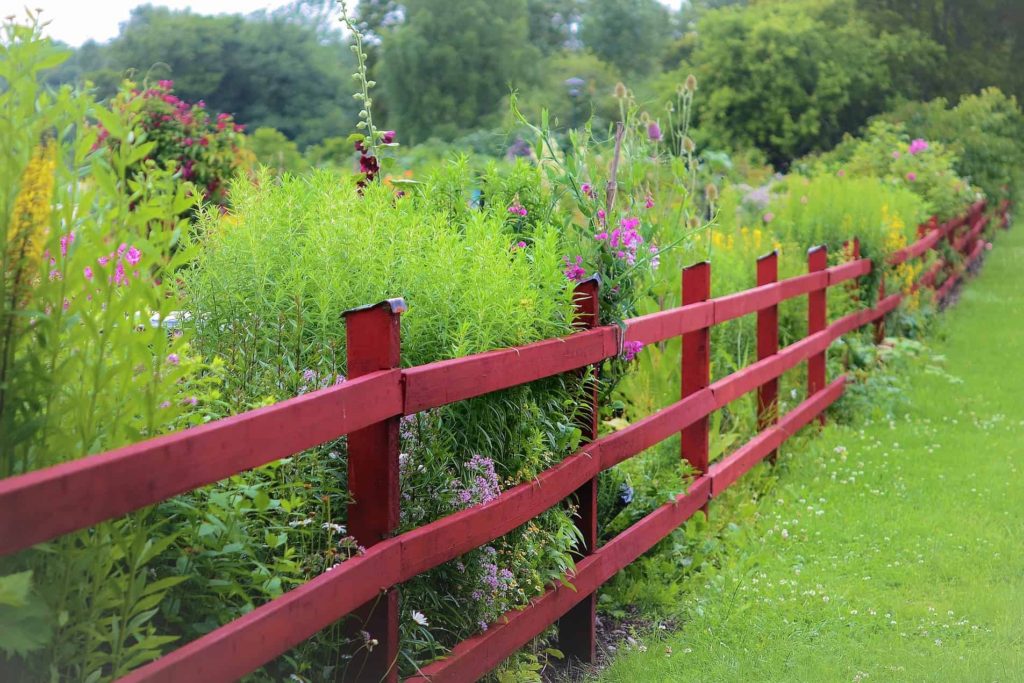
Springtime, where I live, is a pretty nerve-wracking time. Some days it’ll be warm and feel like summer is coming, and it might well snow 8 inches the very next day.
As a gardener, I call it nerve-wracking because just when you finally think the weather is going to cooperate and you plan for a weekend to do some garden chores to get things ready, it can suddenly be cold and snowy and you’re out of luck.
Not very helpful for me trying to get my act together.
This is why we’re in need of a good, quick, DIY garden fence idea for this year to get our garden protected from the critters of the world! I want something that I can do start-to-finish in a weekend or less (in just a few hours would be ideal), and preferably something I won’t spend a fortune on! Saving time on my chores to improve my gardening success is super important around here!
We had a pretty nice, simple DIY garden fence around our plot in the past years, but after each year our garden seems to have expanded, taking the fence with it. (If only we had been more careful to plan our vegetable garden better at the start…)
We’ve never re-anchored it, we’ve added some extension pieces every year, and more recently our new “puppy” (70+ pounds) has taken a shine to practice his hurdle jumps over it, so it’s been crashed into and kicked down in some places.
Let’s just say that by now this fence has taken enough beatings that it’s just as much work to repair it as it’ll take to just replace it entirely.
Table of Contents
How To Choose The Right DIY Garden Fence For Your Needs
Honestly, this really comes down to preference in the most part, although obviously, the environment will factor in some.
We have a fully fenced back yard, which is lucky for us since it keeps the deer out of our garden. Because of that, I don’t have any need to build a super tall deer-proof fence for that reason.
We do, however, have rabbits and neighborhood cats that occasionally come and go despite the fenced yard, but most importantly I’d like to keep my rough-housing dogs from trampling our plants while they play!
In general, the things you’ll want to consider when designing your DIY garden fence are:
- Am I trying to keep anything out (deer, pets, kids), or is it purely for looks? (Some dogs, for example, will respect even a 12-inch tall boundary, where others need 3-4 feet tall to understand “stay out.”)
- Do I want my fence to double as plant support? (Cucumbers, tomatoes, peas, beans, etc can all be trained up the fence to both maximize garden space and minimize the work of installing extra plant supports over the season.)
- Is your garden a plot in the yard or a raised bed? (You might want to fence entirely around a group of raised beds, for example, or you might prefer to fence each one by itself.)
- What materials might I already have on hand to put towards the build? (Think scrap lumber, chicken wire, metal stakes, etc.)
- How much am I willing to spend to build a fence? (If you’re designing a fence for your very first garden that hasn’t been dug yet, you might consider shrinking the garden some so that the fence fits your budget, rather than try to make the budget fit the fence.)
- What is the general “look” I want in my yard (rustic, modern, classic, etc)?
- Do I need to or want to be able to move the fence at any point, or will a totally fixed/permanent installation be the best choice?
How To Build Your DIY Garden Fence
It’s honestly so simple to build your own fence that it always stuns me that so many people don’t it, even for more than just their gardens!
Most people think of “building their own fence” in terms of going to somewhere like Home Depot and just buying fence panels and posts to install themselves, instead of hiring a company to do the labor for them.
While that’s an entirely valid option, especially in terms of time savings versus some other fence designs, it’s unlikely to be your cheapest option.
But with this list of ideas and a little bit of work on your part, you’ll be able to not just build a fence for a much better price than buying pre-made fence panels, but you’ll also be able to build a fence you’re proud of!
Steps to follow to build your garden fence:
- Measure the size of your garden. You’ll obviously need to know how big your garden is (or how big you’d like it to be), so that you can plan for materials accordingly. This could play an even bigger role if you are buying pre-made fence panels and would prefer to not do any cutting to adjust the size of the panels. At this point create a rough sketch of your shape/height, etc to have those numbers for later.
- Check with your town for any permit requirements. Where we live, we would be required to get a permit to install any permanent fencing. If we were to make a fence as simple as wooden stakes in the ground to hold up some chicken wire, which could be removed to roll up and store at the end of the season, this is just temporary fencing and wouldn’t require a permit. Do yourself a favor and avoid any big fines by doing things right from the start!
- Choose your desired look. Since the permit requirements might affect your preferred look, it’s smart to wait to design your fence until after you know the rules. If certain types of fencing require a permit with a fee you’re not willing to pay, then you may as well get back to the drawing board. Choose something that fits with both the surroundings of your environment as well as the general feel of your home. A classic farmhouse with a red barn nearby probably would look odd with something like old bike tires or wine bottles used to make the garden fence.
- Source your materials. For our fence, we intend to use pallets, assuming we can find enough of them for free. If we are unable to find good quality pallets that can withstand the weather (i.e. treated pallets), then we’ll go with plan B and build a simple split-rail style fence using cheap lumber from a store. Start searching for both what materials will be most easily/readily available, and where to get them from for the best price (or even free). If you want to use pallets to save a ton of money, try searching Craigslist or asking at local businesses.
- Get building! With the legal part checked, the materials sourced, and the design already planned, you’re ready to get to work! I’d always encourage enlisting some close friends or family to help to make the job go faster (and more fun)!
DIY Garden Fence Inspiration
Personally, I got tired of seeing tons of pallet fence designs, because they pretty much either go vertically or horizontally and then you’re just about out of options. Maybe it’s just me, but I wanted to find some fence ideas to inspire me that had a little more character to them but weren’t too artsy or “out there” for most settings!
You’ll notice that, in keeping with my love of repurposing, a lot of these ideas have natural materials included. I firmly believe that the more natural your fencing can be, the better!
Check out this collection of some great, easy DIY garden fences! Any of these concepts could easily be replaced with materials you can purchase at a store, so don’t let these images limit you — use them to inspire your very own never-before-seen design!
Simple Pallet “Picket” Fence
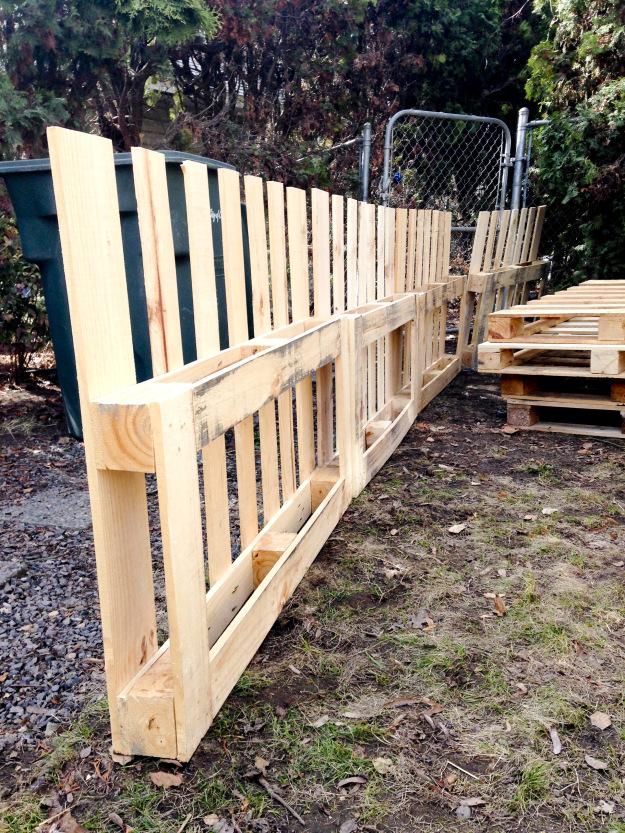
Found on Fairy Wings And Dinosaurs
I think this must be the simplest, cheapest, and most universally-fitting fence style on this list. With a little extra work put in to dog-ear the corners, you’d have a fence that at a quick glance would totally look store-bought!
Short, Wired Bamboo Stake Fence
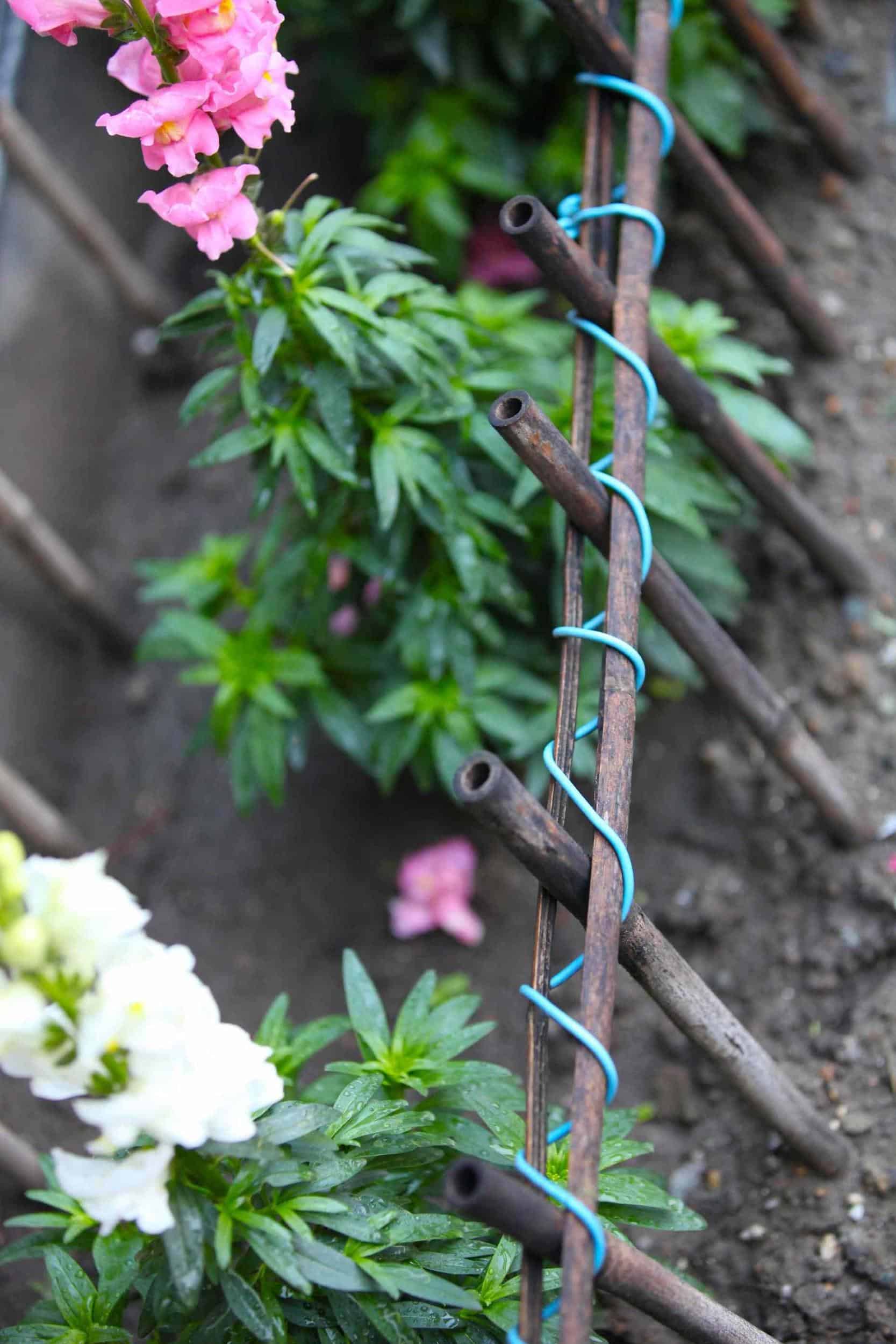
Found on Pioneering The Simple Life
I wish I had seen this idea before I got rid of a bunch of broken bamboo stakes we had last summer! This would have perfect for around a few flowerbeds that our younger dog can’t seem to stay out of!
Woven Willow Fence
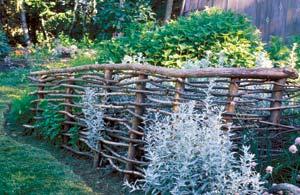
Found on Mother Earth News
This is one of those designs that makes me think of something you’d find outside an old frontiersman’s house in the woods, way back when they were first pioneering across America. Regardless, I love it! So simple to make if you’ve got the right branches!
Stacked Log Fence

Found on Old House Web
This is the perfect fence design for those who live in a wooded location! All you’d need are the stakes to act as the vertical supports, and you simply stack up large sticks or smaller logs in between! I love that the height is so easy to customize, depending on your needs.
Twig Palisade Fence
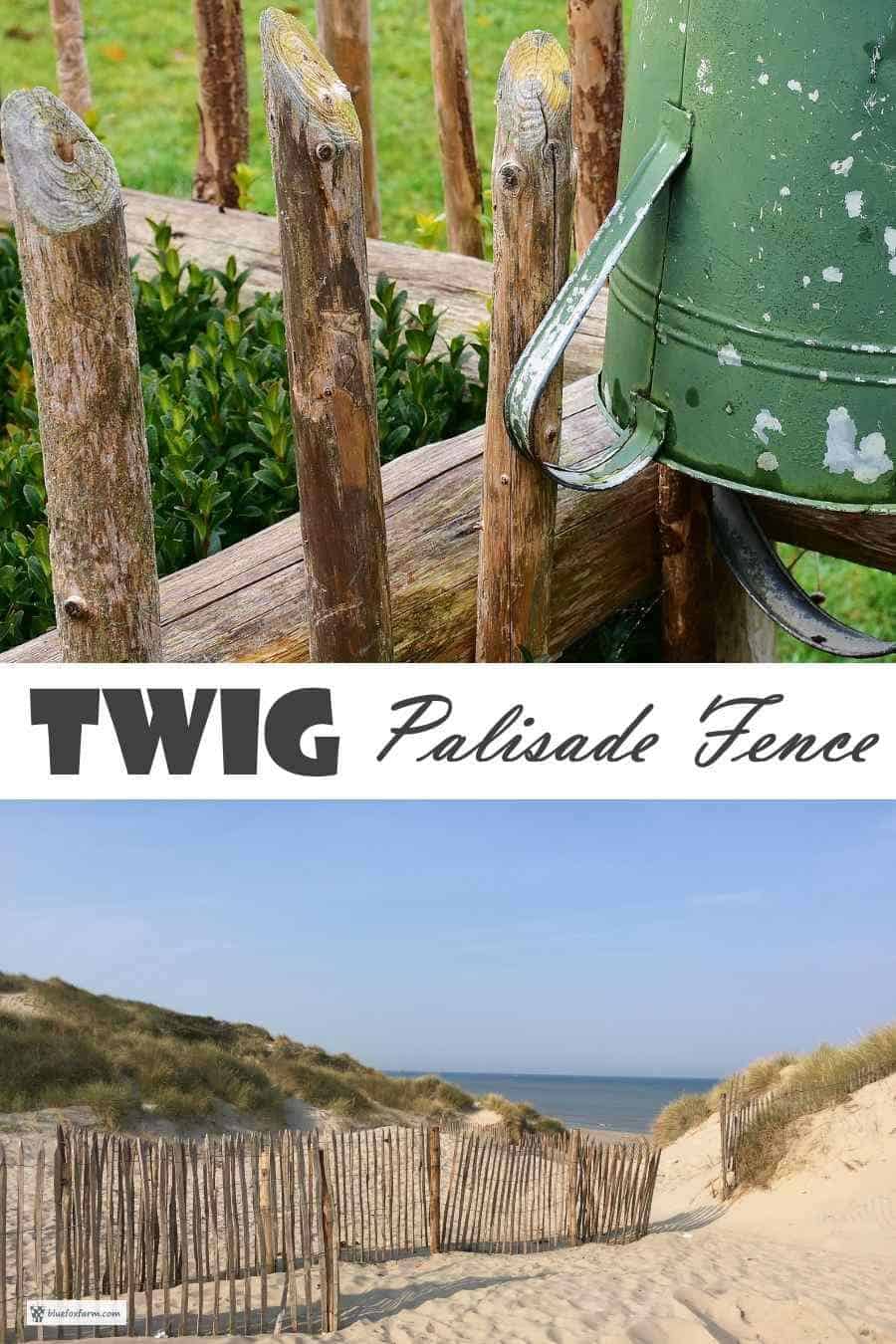
Found on Blue Fox Farm
As you can tell, this is easily a nice “beachy” style fence, but it’s really just a primitive, rustic picket fence in its own way that would be just at home in a wooded flower garden as outside a California beach house garden. Collect sticks around your yard or neighborhood and use a spool of wire to make the panels for this design!
Split Rail Fence

Found on Popular Mechanics
What I love about this fence is how simple it is, as well as how EASY it can be to put together and customized! While admittedly the true “split rail” materials seem to be pretty hard to come by in our area, we’ve based our new garden fence off of this style. Simply put 4x4s in the ground as posts, and use smaller lumber like 1x6s screwed on as the “rails.”
For keeping out both dogs and smaller critters, we’ll be putting chicken wire across the bottom-most opening.
Pre-Made DIY Garden Fencing
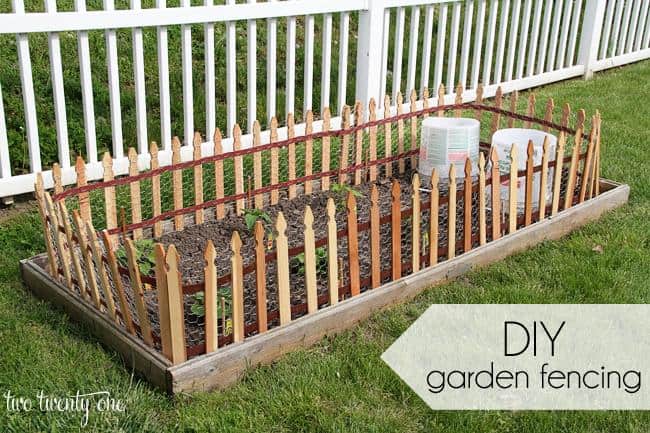
Found on Two Twenty One
This is the perfect fence style for a super fast and super simple fence, especially for raised beds or if you just need a simple line to know where to stop mowing the yard! This little picket fence is pre-assembled in a roll — just buy it and install!
DIY Staked Garden Fence

Found on Oh Everything Handmade
This is similar to what we’ve done to add “extension pieces” as our existing garden fence had to expand. Simply buy some chicken wire or net fencing, attach to wooden stakes, and hammer into the ground. You’ll have your DIY garden fence built in probably minutes with this design!
Framed Hog Fencing
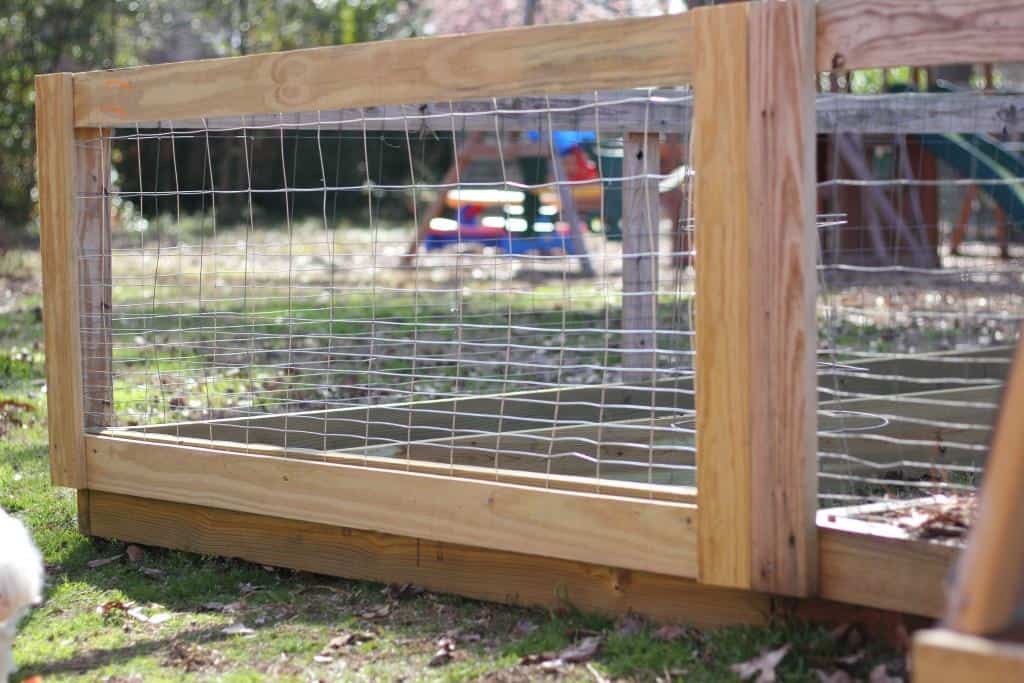
Found on The Kitchen Garten
This is a simple but visually-pleasing fence that takes just a little bit of time and effort but is super straightforward to make. You can buy either rolled hog fencing, chicken wire, or even large stiff livestock panels, attach them to a custom-sized wooden frame, and attach to the outside of a raised bed or to sunken posts for an effective and easy garden fence!
Pre-Made Picket Fence Installation
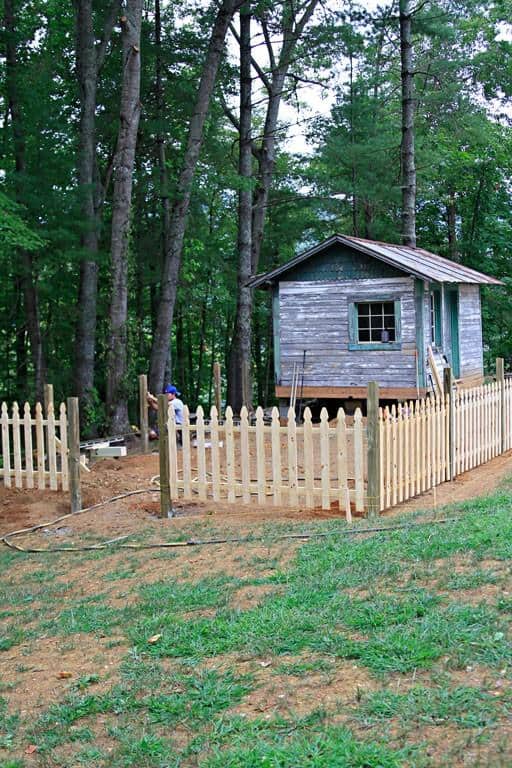
Found on Lil Blue Boo
Ok, so this is maybe one of the least “DIY” options on the list, but like we discussed above it’s still much cheaper to buy the panels and install them yourself than it would be to hire a fencing company. Not to mention it IS a good time saver versus building all your own panels if you just have to have that classic picket fence look!
DIY Screened Panel Fence For Raised Beds
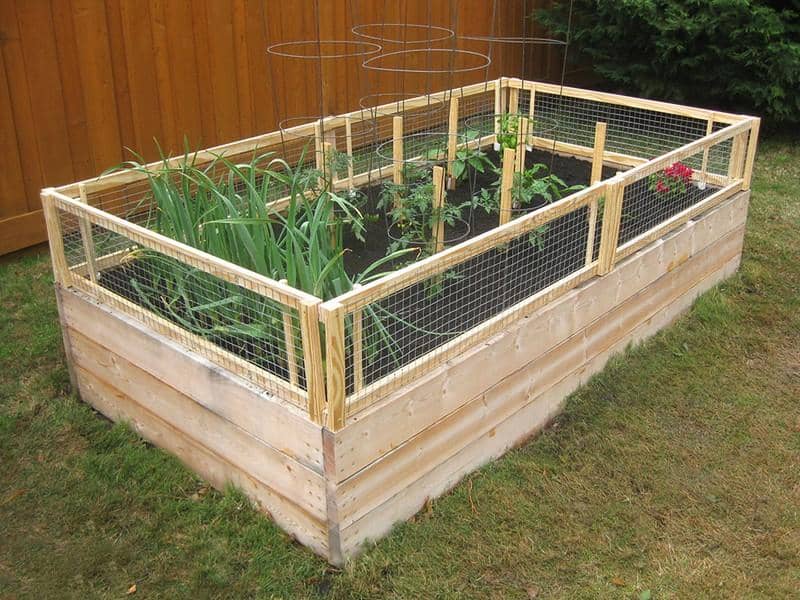
Found on The Owner Builder Network
The thing I love about this option is that you can save a little money by making the screened panels yourself, or you can save a little more time by buying these screens pre-made. In this tutorial, they’ve used PVC piping to act as holders for the screens, to make them easily removable for quick access! Genius!
Simple Woven Branch Garden Fence
Photo by Jean Marsh Design – Discover landscaping design ideas
Found on Houzz
This is obviously similar to the woven willow fence above, but it obviously requires many fewer branches to have a completed look. While the first option might be the better choice if you’re constantly pestered by rabbits, this might be the faster and better choice if you just need something for looks or to keep kids out!
Rustic Stacked Log Rail Fence
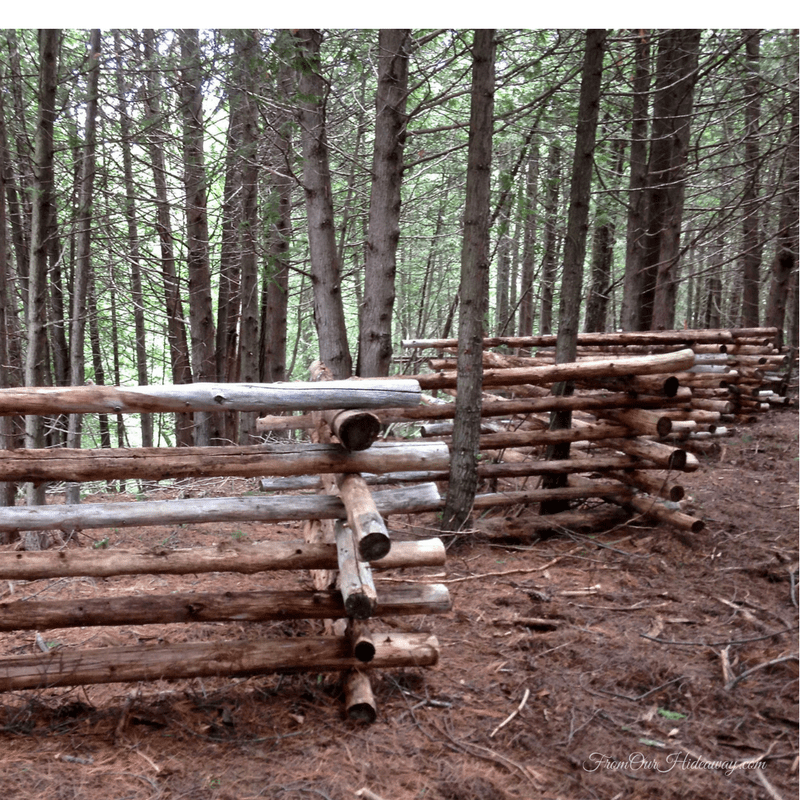
Found on From Our Hideaway
I’m sure you’ve seen a fence like this if you’ve ever driven down some old backroads. There really isn’t much to this design — if you’ve ever played with Lincoln Logs, you’ve already got the skills (mostly)!
Bamboo Stalks DIY Fence
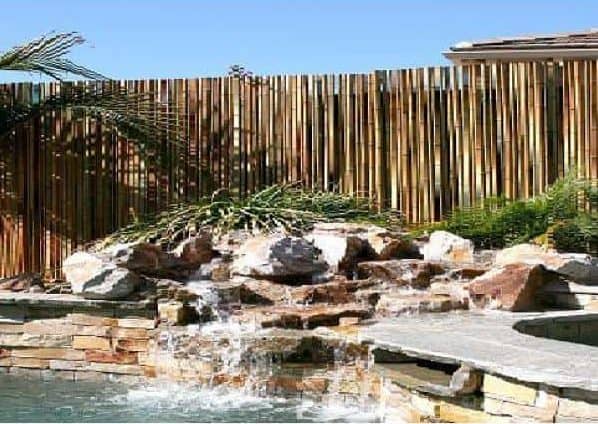
Found on Home Depot
This admittedly wouldn’t be my first choice because of having a higher cost than most options on this list, but it’s worth including for those with other fencing needs than myself!
These are 4-foot tall panels, which could, in theory, be cut in half to be 2-foot tall panels if you’re simply in need of a lawn divider more than an actual functionally restrictive fence.
Simple Pallet Fence
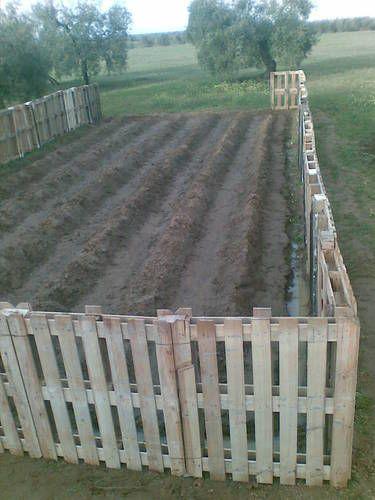
Found on Bless My Weeds
This design is obviously a lot like the very first one on our list but with one obvious difference: the pallets in this plan are entirely uncut (whereas the originals were cut down to have loose wood ends at the top). Simple drop the pallets over buried posts and tie in place and you’re all set!
Modified Split Rail DIY Fence
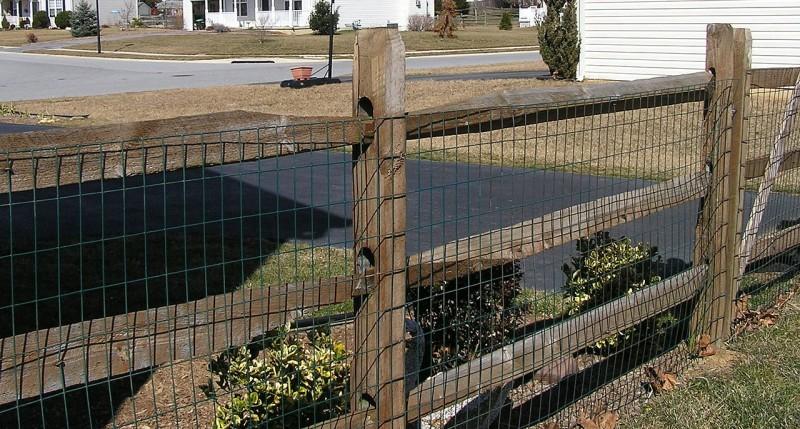
Found on Morning Chores
This fence is included to show the customization possible for a split-rail style fence, such as more rails or adding almost any kind of wire for additional barrier functionality. Maybe your lawn already has a split rail or similar fence around it and adding the wire barrier would be enough to keep your garden safe!
Logs & Wire DIY Fence
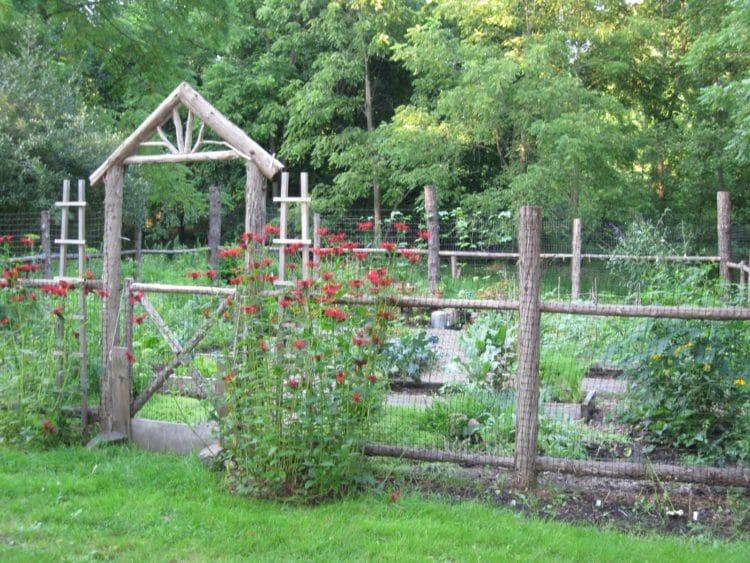
Found on The Art Of Doing Stuff
Unfortunately, I couldn’t track down a tutorial for this exact fence, but it still appears to be fairly straightforward to design and build. Bury the thick vertical posts, screw on a couple of horizontal rails made of smaller logs, and attach wire fencing or deer netting for a quick and natural fence!
Semi-Permanent Picket Fence DIY
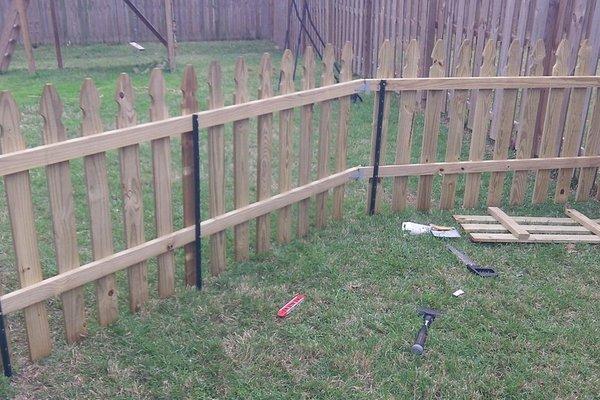
Found on Instructables
This is similar to the tutorial above for building a formal, permanent picket fence except that this fence requires a lot less work to install, and it’s totally possible to remove it if needed! If you’ve got a larger garden like us and use a tractor attachment to till your garden each year, this might be a perfect design to make it easier to get into and out of the garden with your equipment.
Simple Staked Lattice Fence
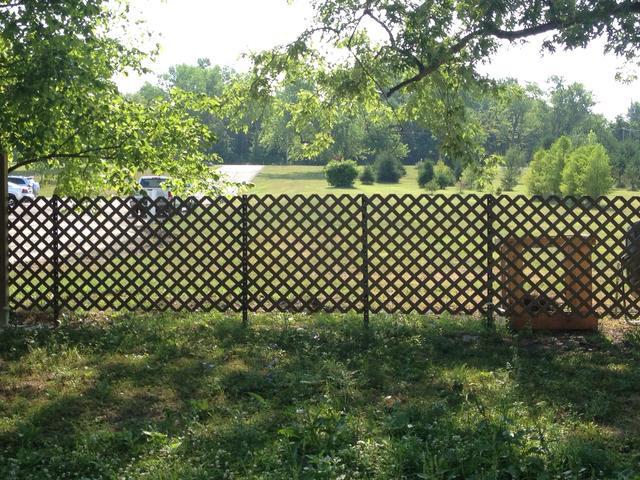
Found on Snap Guide
This is the same sort of build and installation as the semi-permanent picket fence just above. Simply drive some metal stakes into the ground and zip tie or wire on some lattice panels!
Simple Lumber & Wire DIY Garden Fence

Found on Grandma’s House DIY
While this image is obviously showing deck rails, there’s no reason this couldn’t be applied to posts in the ground around your garden! The tutorial uses conduit piping for a much sturdier application, but you could make this DIY fence as easily as drilling holes in some 2x4s, then running stiff wire through each post, end to end along each side of your garden!
This would be an especially good design for gardens on a hill, where traditional fencing would be difficult to install.
Which of these fencing ideas is your favorite? Leave a comment to share!
Join us in Finding Good Living on Facebook to share pictures of YOUR custom DIY garden fence in all its glory! I’d love to see it! 🙂


heyy this is the article I was looking for. I wanted to add a fence in my lawn for beautification and I was wondering where to start. Now I know what to do. I’ll definitely look up if there are any laws regarding fencing in our area. If so I’ll abide by that
Amazing post!
In my opinion, Picket-style garden fencing gives a boundary without removing your plot from the rest of the world – the low stature welcomes collaboration, while the holes between pales give a brief look at the nursery past. This kind of fencing configuration is incredible for partitioning a vegetable fix for insurance from pets and youngsters.
Picket fencing is definitely one of the most eye-catching designs, I agree! If only it were more affordable (and more deer-proof) for larger garden sizes like ours!